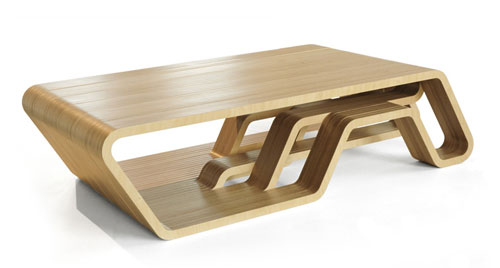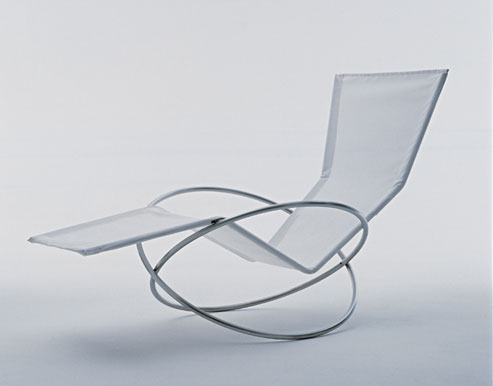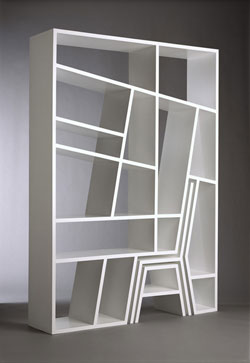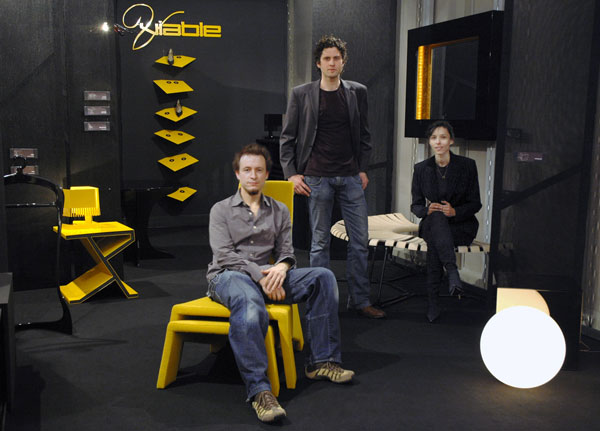Career interview: furniture design
Gala Wright and Charles Trevelyan are two thirds of the London design studio Viable. But design wasn't the first choice for either of them and they came from what might be a surprising background for creative workers. Both studied science at university first, then took sideways steps working in very different jobs, and only came to design in the last few years. They talk to Plus about the different turns their lives have taken, and how the science they studied, and other life experiences they gained along the way, have contributed to their success as designers today.
Starting in science
Both Gala and Charles were always aware of their competing interests in the arts and in the sciences, and what to study at university wasn't a straight forward decision. When Gala first went to Oxford, she took oriental studies, but soon realised it wasn't for her. "At the time I didn't know what to do as I was good at sciences [as well]," she says. She found the answer in a more unusual course.
"Physics and philosophy appealed to me because at the time it seemed to cover all the bases — because I was quite good at arts, and quite good at sciences, and I wanted to do an all-encompassing degree which was more brain training than application." So Gala moved to King's College, London, to study physics and philosophy, finishing her degree in 1991. "It's quite an unusual course, even though it shouldn't be — all the greatest physicists were (and are) also philosophers."
Charles had similar thoughts when he was deciding what to do. "Kind of like Gala, starting off in engineering wasn't really because I wanted to do engineering for ever more, it was just the degree I chose to do at the time. For me it was always a choice between engineering and science, or something like architecture or design. And really what it came down to was [that I knew that] if I did engineering first I could always come back to design, but the other way around would [have] been much more difficult."
He studied science and engineering at the University of Western Australia, specialising in materials engineering, and found it so interesting he nearly stayed in science when he finished his honours year in 1995. "I was on the verge of doing a PhD and going on to research for ever more." But when he sat back and thought it through, he decided he needed something more creative to sustain him for a full career. So after a brief spell of consulting work in engineering, Charles did a postgraduate diploma in 3D design at Curtin University in 1997.
A sideways step, then back on the design path
At this point Charles veered away from design and spent most of his time playing in a band for the next few years. But design was never far away. In fact, it was music that lead Charles to graphic design, producing CD covers, posters and other promotional material for the band. He decided he wanted to pursue design again full time, and moved to the UK in 2000. Once here, he continued to work in graphic design for a number of years (Plus is lucky enough to have Charles as our graphic designer) until he returned to 3D design in 2004. "Finally after working in [purely] graphic design for a few years, I decided I wanted to get into the 3D side of things again, and started doing furniture."

Harmonic, coffee table, by Charles Trevelyan, 2005
Gala says her career certainly didn't follow directly from physics to design:"In fact I have been all over the place". She worked in film directly after leaving university, "which was more of a 'I need to get a job' [decision]. There was one available and I got stuck in that until I decided to work out what I really would like to do — what is going to be the best use of my brain and what is going to work for me?"
Looking back at what she enjoyed, even as a child, Gala realised she loved building things: "I was the kind of kid that built robots as opposed to play hairdressing with dolls!" she says. Gala's mother, who was a great collector of design from textiles to ceramics, also gave her an appreciation of design. "And apparently I did say at one point when I was little: 'I want to make furniture'!"
One experience that helped Gala realise she wanted to be a designer was attending an exhibition of the work of Buckminster Fuller: "He was a mathematician and a designer and architect — he was very cool!". The exhibition included his well known creations the Dymaxion house and car, and the geodesic dome. Gala was so inspired by his work that she thought: "This is who I wish I could be, I want to invent." His influence can be seen in some of her work, such as the Loop Lounger, which adheres to his "greatest with least" principle — "using the minimal amount of material as possible to provide your outcome" Gala says. (You can read more about Buckminster Fuller at The Buckminster Fuller Institute, on the MacTutor History of Mathematics archive, at the London Design Museum, and in the Plus article "The art of numbers".)

Loop Lounger, by Gala Wright, 2003
Gala decided to study furniture design at the London Guildhall (now London Metropolitan University) in 2000. She studied the HND course — "the more practical sort of course" — and took a year out in 2002 to have a baby. Motherhood became part of the inspiration for her final year project, the Loop Lounger, which was taken on by an Italian manufacturer, Coro.
The science and style of design
The Loop Lounger has a minimal, geometric look: just two circles and the cradle of material between them. There is a carefully positioned balance point that allows the lounger to rock easily, but not tip out the one who lounges! "I'd just had a baby and I was thinking about cradles, and how ugly they all are!" says Gala.
Starting with two circles, she quickly realised putting them together would give her a frame that rocked. Although her first idea was to make a cradle with a basket on the underframe of those two circles, she decided to try making it a chair instead. "I realised for it to balance it would work better as a lounger," and although physics gave her some instincts as to where the balance point would be, making it work required "lots of time jiggling about with the frame in the work shop".
Gala definitely feels she uses her mathematical science background in her work. "The physics of materials is really important, it is certainly necessary in design to have an idea of how things are going to behave. [As is] structural analysis, which can be a very mathematical process." Although she might not have to do all the calculations, she feels that there is an awareness of what is involved at a subconscious level due to her training.
Gala's designs often involve tension and balance, having a minimal, geometric quality to them. "Physics certainly has a massive influence," she says. "Using different things like tension, like I did with the Loop Lounger, probably is partly to do with my background."

shelflife, a shelving unit or room divider, by Charles Trevelyan, 2005
Charles' pieces often have a geometric aspect to them as well. His integrated shelving and chair unit, shelflife, features a chair and stool nestled among many angled shelves and compartments. He explains that the angular nature of shelflife came from the idea of having the chair within the shelves: "The whole form of the shelves derived from the position of the chair."
The piece required a lot of experimenting to decide what angles worked - both functionally and visually. "Fundamentally books are a certain size so you've got to plan it around that, and plan it around being a functional object that stands up!" Structurally, a certain amount of uprights need to go through the shelves to support it. But these functional considerations mean that it would be easy for the shelves to be too complex and too busy. "It is a balance between keeping enough shelves in there so it is self-supporting and functional, but at the same time it didn't become too overbearing." The answer was to have the chair dictate the angles for the whole piece. All the parts are horizontal or vertical, or they run parallel or perpendicular to the 10 degree angle of the chair.
Taking shelflife from an idea to reality required some serious trig action. It may seem surprising that there is maths involved, but it is vital to be able to calculate angles, lengths and positions when formalising a design and preparing the technical drawings for those who will build the piece.
Charles says there is an element of mechanics too, needing to know balance points, and also getting the ergonomics right — "the ratios of the size of person to the object, and how the form of the object relates to the size of a person and how it is used — so there is a degree of calculation there." Although some of these calculations can be avoided by using computer programs to create models of the designs, Charles still feels that "there is an awareness of form and geometry in using those programs", and of course a lot of mathematics has gone into creating the computer programs themselves.

Delta Chair, a modular seating system, by Gala Wright, 2006
Both designers feel that they are able to take more risks with design because they understand the science behind making furniture that works, but equally they sometimes push the limits despite knowing these physical constraints. "I have an instinct about it, but I am always trying to push it," says Gala. When exploring more risky designs, she might know "there is a reason chairs aren't made that way" and her science and design experience tells her what that reason is. "[But] knowing about it doesn't stop me from trying to cheat physics regularly!" One example is a three legged stool she worked on for Habitat: aesthetically the idea worked, but despite great effort, physics won out in the end.
Charles says that his background in engineering has given him "an intuitive understanding of where weak points might be, or how far you can push things". It means that "you can look at a design and work out what the potential problems might be, rather than having to make it and find it collapses. You know where you are going to have to address the mechanics, and where you can just play around with the form."
Gala's theoretical physics degree may not have given her many more practical skills to use in design than studying maths and science to A level, but it did further develop her problem solving skills. "The degree is good brain training," she says, and she even says that her style as a designer is all about problem solving.
The future
After Gala worked for Habitat for a year and Charles worked as a graphic designer, they met each other, and their colleague Magnus Long at the Milan Furniture Fair in 2005, where they were all exhibiting for the first time as part of the Hidden Art show. They have since formed a design studio together, Viable, launching last year in the London Design Festival and exhibiting again as a studio in Milan this year.

Viable at the Milan Furniture Fair. From left to right: Charles Trevelyan, Magnus Long and Gala Wright.
Their advice to other people interested in pursuing design is to take your time. "Go and do something else first!" says Gala. Both agree that life experience is key, and although it isn't an obvious path into design, having a background in a mathematical science has given both the "brain training" that has proved useful in design.
Obviously it is important to have an appreciation of aesthetics and the visual side of design, but Charles emphasised that "there is also a lot of problem solving and it is not just visual problem solving". You need to be able to understand the mechanics of how things are put together and how they work. "[You need to be able] to look at an object and analyse how it can be improved or why it doesn't work." And once you have solved the problems of how to construct your design in reality, you need to be able to communicate these technical details to the people manufacturing it. Both problem solving and communication of complicated ideas are skills you will gain in a mathematical science degree.
Gala suggests that the design course you do should have a practical side. "[Design] is not like art, it is not a purely creative exercise by any stretch." She suggests courses that enable you to learn about materials and the science of design, as well as how to draw and the more obvious skills associated with it. "And don't underestimate the science in design!"
Further reading
- You can find out more about Gala and Charles' work on the Viable site.
- Read about the science used to design the beautiful Nautilus speakers in the Plus article Designing loudspeakers.
- Find out more about maths in art and design in previous Plus articles.
About the author
Rachel Thomas is co-editor of Plus.